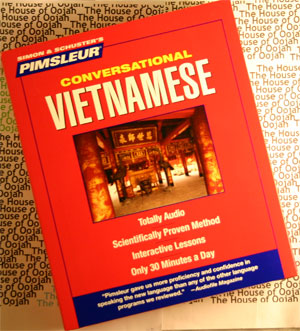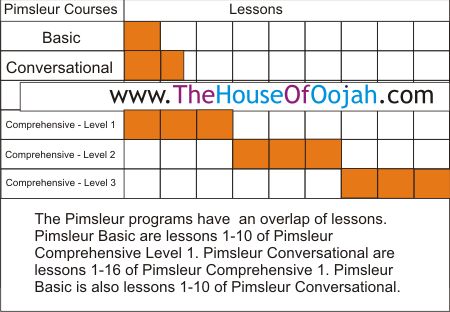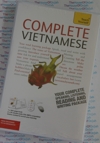Pimsleur Conversational Vietnamese - 8 Audio CDs - Learn to Speak Vietnamese
|
Brand New Audiobook Pimsleur Conversational Vietnamese - Audio CD8CDs 16 Lessons Audio CDs play on Car/Portable/Home CD player |
 |
Pimsleur Conversational Vietnamese - Audio CDBrand New : 8 CDs HEAR IT, LEARN IT, SPEAK IT About the Vietnamese Language:Vietnamese (tiếng Việt, or less commonly Việt ngữ), formerly known under the French colonization as Annamese (see Annam), is the national and official language of Vietnam. It is the mother tongue of the Vietnamese people (người Việt or người Kinh), who constitute 86% of Vietnam's population, and of about three million overseas Vietnamese, most of whom live in the United States. It is also spoken as a second language by some ethnic minorities of Vietnam. It is part of the Austroasiatic language family, of which it has the most speakers by a significant margin (several times larger than the other Austroasiatic languages put together). Much vocabulary has been borrowed from Chinese, and it was originally written using the Chinese writing system. The Vietnamese writing system in use today is an adapted version of the Latin alphabet, with additional diacritics for tones and certain letters. Classification Vietnamese was identified more than 150 years ago to be part of the Viet-Muong (or Vietic) grouping of the Mon-Khmer branch of the Austroasiatic language family, a family that also includes Khmer, spoken in Cambodia, as well as various tribal and regional languages, such as the Munda languages, spoken in eastern India, and others in southern China. Even though this is supported by etymological comparison , some linguists still believe that Viet-Muong is a separate family, genealogically unrelated to other Mon-Khmer languages. History It seems likely that in the distant past Vietnamese shared more characteristics common to other languages in the Austroasiatic family, such as an inflectional morphology and a richer set of consonant clusters, which have subsequently disappeared from the language. However, Vietnamese appears to have been heavily influenced by its location in the Southeast Asian sprachbund—with the result that it has acquired or converged toward characteristics such as isolating morphology and tonogenesis. These characteristics, which may or may not have been part of proto-Austroasiatic, nonetheless have become part of many of the phylogenetically unrelated languages of Southeast Asia—for example, Thai (one of the Tai-Kadai languages), Tsat (a member of the Malayo-Polynesian group within Austronesian), and Vietnamese each developed tones as a phonemic feature, although their respective ancestral languages were not originally tonal. The Vietnamese language has similarities with Cantonese in regard to the specific intonations and unreleased plosive consonant endings, a legacy of archaic Chinese. The ancestor of the Vietnamese language was originally based in the area of the Red River in what is now northern Vietnam, and during the subsequent expansion of the Vietnamese language and people into what is now central and southern Vietnam (through conquest of the ancient nation of Champa and the Khmer people of the Mekong delta in the vicinity of present-day Ho Chi Minh City), Vietnamese was linguistically influenced primarily by Chinese, which came to predominate politically in the 2nd century B.C.E. With the rise of Chinese political dominance came radical importation of Chinese vocabulary and grammatical influence. As Chinese was, for a prolonged period, the only medium of literature and government, as well as the primary written language of the ruling class in Vietnam, much of the Vietnamese lexicon in all realms consists of Hán Việt (Sino-Vietnamese) words. In fact, as the vernacular language of Vietnam gradually grew in prestige toward the beginning of the second millennium, the Vietnamese language was written using Chinese characters (using both the original Chinese characters, called Hán tự, as well as a system of newly created and modified characters called Chữ nôm) adapted to write Vietnamese, in a similar pattern as used in Japan (kanji), Korea (hanja), and other countries in the Sinosphere. The Nôm writing reached its zenith in the 18th century when many Vietnamese writers and poets composed their works in Chữ Nôm, most notably Nguyễn Du and Hồ Xuân Hương (dubbed "the Queen of Nôm poetry"). As contact with the West grew, the Quốc Ngữ system of Romanized writing was developed in the 17th century by Portuguese and other Europeans involved in proselytizing and trade in Vietnam. When France invaded Vietnam in the late 19th century, French gradually replaced Chinese as the official language in education and government. Vietnamese adopted many French terms, such as đầm (dame, from madame), ga (train station, from gare), sơ mi (shirt, from chemise), and búp bê (doll, from poupée). In addition, many Sino-Vietnamese terms were devised for Western ideas imported through the French. However, the Romanized script did not come to predominate until the beginning of the 20th century, when education became widespread and a simpler writing system was found more expedient for teaching and communication with the general population. Geographic distribution As the national language of the majority ethnic group, Vietnamese is spoken throughout Vietnam by the Vietnamese people as well as by ethnic minorities. It is also spoken in overseas Vietnamese communities, most notably in the United States, where it has more than one million speakers and is the seventh most-spoken language (it is 3rd in Texas, 4th in Arkansas and Louisiana, and 5th in California). In Australia, it is the sixth most-spoken language. According to the Ethnologue, Vietnamese is also spoken by substantial numbers of people in Australia, Cambodia, Canada, China, Côte d'Ivoire, Finland, France, Germany, Laos, Martinique, Netherlands, New Caledonia, Norway, Philippines, Poland, Senegal, Thailand, United Kingdom, United States and Vanuatu. Official status While spoken by the Vietnamese people for millennia, written Vietnamese did not become the official administrative language of Vietnam until the 20th century. For most of its history, the entity now known as Vietnam used written classical Chinese for governing purposes. Written Vietnamese in the form of chữ nôm was used for administrative purposes during the brief Ho and Tay Son Dynasties. During French colonialism, French superseded Chinese in administration. It was not until independence from France that Vietnamese was used officially. It is the language of instruction in schools and universities and is the language for official business.
|
Pimsleur Conversational Vietnamese - Audio CD |


 0 Items (Empty)
0 Items (Empty)

